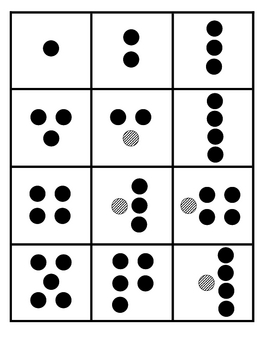In the last couple weeks of our Number Talks, students have shared many
different ideas about how they view the pips (black dots). The goal in my mind
at the moment has been primarily to develop a sense of comfort for all students
to share their ideas in our classroom and create an encouraging community. At
the moment, there is no right or wrong answer since we are simply asking the
question “What do you see?”. Beginning with this open-ended question is
important so that students understand that everyone visualizes numbers differently.
Last week I found this question invigorated students and I was eager to
allow many students a chance to share; but this slowed down the process and
students had trouble focusing. This past week I limited the amount to 3
students sharing for each card and this helped us keep our attention. Our
students began sharing really wonderful descriptions about the pictures they
see within the dots; it was interesting to watch our focus shift from last week
with numerical descriptions related to subtraction to creative connects to
objects in the real world.
 |
| What do you see? |
While it is very important to encourage students to think creatively and
create this positive atmosphere where students aren't afraid to share their
ideas, after our class on Number Sense and having read the article on Subitizing: What is it? Why Teach it?, by
Douglas H, Clements, I have a deeper
understanding of the goal of our Number Talks. This article reminded me that subitizing
means “instantly seeing how many”. I
learned that perceptual subitizing
means being able to recognize a number without using any mathematical thinking
and conceptual subitizing means being
able to recognize a number as both the whole and the unit (i.e. You can roll a
die and see 2 groups of 3 or one group of 6.)
These skills are important to develop prior to learning more complex addition
and subtraction procedures. And as Clements suggests: “Young children may use perceptual
subitizing to make units for counting and to build their initial ideas of
cardinality.” I had to review the concept of cardinality from the Kindergarten Math
Continuum from our school board: “Identify the quantity of items in a
collection where the last counting word tells how many (e.g. ‘1, 2, 3, 4… there
are 4’)”. Eventually, students begin to conceptually subitize through these counting
and patterning abilities and will “discover essential properties of number,
such as conservation and compensation… [and] develop such capabilities as
unitizing, counting on, and composing and decomposing numbers as well as their
understanding of arithmetic and place value” (Clements). Thus, through our
Number Talks, our goal is to develop students’ ability to conceptually subitize,
laying the foundation for future understanding of strategies for addition and
subtraction.
Clements notes specific arrangements of sets that make subitizing easier
for children to learn. “Children usually find rectangular arrangements easiest,
followed by linear, circular and scrambled”(Clements). It is also important to
note he says that preschoolers aged 2-4 cannot conceptually subitize and that
for sets of 1-4, no arrangement is easier than any other, but linear is easiest
when the set is larger than 4. This means that my 4-year-old kindergarten
students are likely to be counting each item but eventually by the end their
second year of kindergarten, students will begin to conceptually subitize.
Clements also suggested there are several number activities that will help
students develop the ability to subitize.
Activity 1
Give each child cards with zero through 10 dots in
different arrangements. Have students spread the cards in front of then. Then
announce a number. Students find the matching card as fast as possible and hold
it up. Have them use different sets of cards, with different arrangements, on
different days. Later, hold up a written numeral as their cue. (Clements and
Callahan 1986).
Activity 2
Place various arrangements of dots on a large sheet
of poster board. With students gathered around you, point out one of the groups
as studenst say its number as fast as possible. Hold the poster board in a
different orientation each time you play. (Clements 1999).
Activity 3
My kindergartners’ favorite numeral-writing activities involve auditory
rhythms. They scatter around the classroom on the floor with individual chalkboards.
I walk around the room, then stop and make a number of sounds, such as ringing
a bell there times. They write the numeral 3 on their chalkboards and hold them
up. (Clements 1999).
After watching recordings of our Number Talks, I realised I have been
displaying the dot cards the entire time and allowing lots of time for
reflection while my teaching partner has been flashing them briefly. In order to bring back the focus onto subitizing, “instantly seeing how many”, we will need to change the questions
slightly, and ensure we are both presenting the cards briefly.
My Next Steps:
- Show the cards briefly and then hide them.
- Change the question from “What do you see?” to “How many dots?”
- Record their answers.
- Discuss their answers. If they saw 3, ask “How do you see 3?”
- Find more Table Top Activities and games specifically related to subitizing
These changes in our Number Talks
will help students focus on quantity so their answers should be more numerical.
It will also help them realise there is a correct answer when it comes to
counting an amount, just as there is a correct way to put together a puzzle, but
we may have different strategies for figuring out which pieces go together,
some more efficient than others. We will give them a chance to share their
methods of visualizing the dots and we can continue to celebrate our differing
thought processes, creating a safe atmosphere for all students to share their
ideas. The emphasis is not on having the correct
answer but uncovering different ways
to figure out the puzzle and eventually analyzing which way we feel is most
efficient depending on the situation.
References:
Clements, Douglas H. (1999). Subitizing: What Is It? Why Teach It?
The National Council of Teachers of
Mathematics, Inc. www.nctm.org.
Kindergarten Math Continuum. Teacher Learning and Leadership
Program. OCSB.







